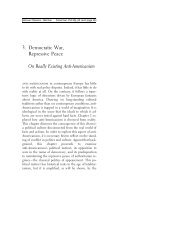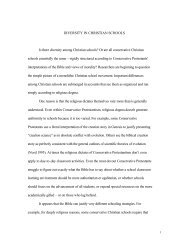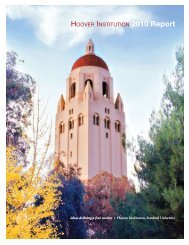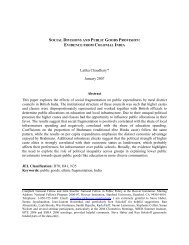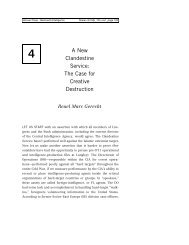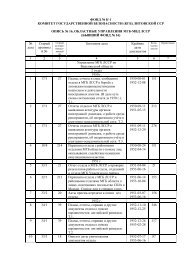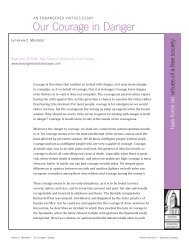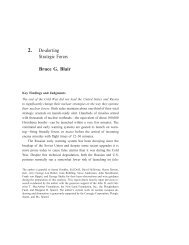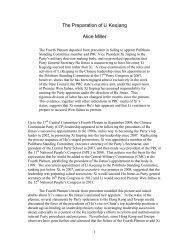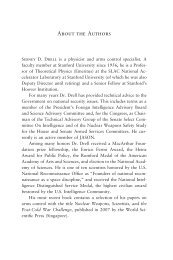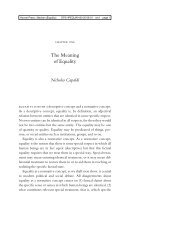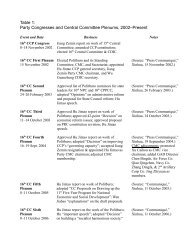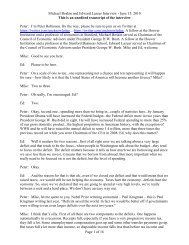Civil Liberties and Security in Cyberspace - Hoover Institution
Civil Liberties and Security in Cyberspace - Hoover Institution
Civil Liberties and Security in Cyberspace - Hoover Institution
Create successful ePaper yourself
Turn your PDF publications into a flip-book with our unique Google optimized e-Paper software.
<strong>Hoover</strong> Press : Cyber DP5 HPCYBE0500 06-11-:1 11:53:04 rev1 page 208<br />
208 Ekater<strong>in</strong>a A. Drozdova<br />
<strong>and</strong> seizures, as well as the limited exceptions to Fourth Amendment<br />
requirements. As such, the guidel<strong>in</strong>es provide a suitable background<br />
for the discussion of the exceptions, draw<strong>in</strong>g upon technical <strong>and</strong> <strong>in</strong>ternational<br />
realities to evaluate their application <strong>in</strong> cyberspace. The<br />
exceptions to the warrant requirement <strong>in</strong>clude: 50<br />
(a) Lack of reasonable expectation of privacy. The Supreme Court<br />
def<strong>in</strong>es a “search” as an <strong>in</strong>trusion by police <strong>in</strong>to an area where <strong>in</strong>dividuals<br />
have a “reasonable expectation of privacy.” 51 Generally, no<br />
one has an expectation of privacy as to someth<strong>in</strong>g that can be observed<br />
by the public. 52<br />
Whether the Internet is a public space or a private space, where<br />
search warrants are usually required, is still legally unsettled. 53 Determ<strong>in</strong>ations<br />
have been made <strong>in</strong> specific cases, depend<strong>in</strong>g on the type of<br />
electronic transmission sent <strong>and</strong> the recipient of the transmission. 54<br />
For example, real-time, Internet conversations observed by an agent<br />
<strong>in</strong> a chat room lacked Fourth Amendment protection, because the<br />
defendant did not have a reasonable expectation of privacy vis-à-vis<br />
50. “Federal Guidel<strong>in</strong>es for Search<strong>in</strong>g <strong>and</strong> Seiz<strong>in</strong>g Computers,” available at http:/<br />
/www.usdoj.gov/crim<strong>in</strong>al/cybercrime/search_docs/toc.htm, additional documents<br />
available at http://www.usdoj.gov/crim<strong>in</strong>al/cybercrime/search<strong>in</strong>g.html. See also<br />
Craig M. Bradley, “United States,” <strong>in</strong> Bradley, ed., Crim<strong>in</strong>al Procedures, pp. 395–<br />
424. Specific cases establish<strong>in</strong>g the pr<strong>in</strong>ciples are noted.<br />
51. Katz v. United States, 389 U.S. 507 (1967).<br />
52. For example, fly<strong>in</strong>g over a suspect’s l<strong>and</strong> <strong>in</strong> a helicopter to verify the grow<strong>in</strong>g<br />
of marijuana (Florida v. Riley, 488 U.S. 445 (1989)), search<strong>in</strong>g trash b<strong>in</strong>s left at the<br />
curb of the house for pickup (California v. Greenwood, 486 U.S. 35 (1999)), <strong>and</strong><br />
us<strong>in</strong>g an electronic beeper to track a car’s location on the highway (United States v.<br />
Knotts, 460 U.S. 276 (1983)) are not considered to be “searches.” However, plac<strong>in</strong>g<br />
an electronic beeper <strong>in</strong> a conta<strong>in</strong>er of chemicals <strong>in</strong> order to determ<strong>in</strong>e whether the<br />
conta<strong>in</strong>er rema<strong>in</strong>ed <strong>in</strong>side the suspect’s house was considered a “search” subject to<br />
Fourth Amendment requirements (United States v. Karo, 468 U.S. 705 (1984)).<br />
53. See Bradley, “United States,” p. 403 for a discussion <strong>and</strong> references on searches<br />
<strong>in</strong> private versus public spaces, such as <strong>in</strong> structures versus outdoors. See also Noah<br />
D. Zatz, “Sidewalks <strong>in</strong> <strong>Cyberspace</strong>: Mak<strong>in</strong>g Space for Public Forums <strong>in</strong> the Electronic<br />
Environment,” Harvard Journal of Law <strong>and</strong> Technology 12 (Fall 1998): 149.<br />
54. Supplement to Federal Guidel<strong>in</strong>es for Search<strong>in</strong>g <strong>and</strong> Seiz<strong>in</strong>g Computers<br />
(1999), available at http://www.usdoj.gov/crim<strong>in</strong>al/cybercrime/supplement/s&sup<br />
pii.htm#IIF.



